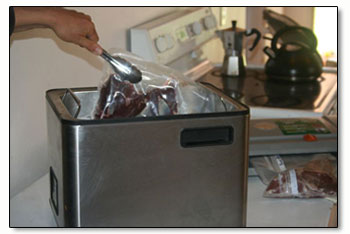|
|
Getting your feet wet with sous videby Ari LeVaux The technology has been common in high-end restaurants for about 10 years. The requisite gear, which comes in many forms, carries a hefty four-figure price tag that’s out of reach for most home chefs. In recent years, a few consumer-level sous vide models have become available in the $500 range. One such unit was sent to me on loan by its manufacturer; it’s basically a stainless steel box with a temperature control unit. You fill it with water, set the temperature, and plop in a vacuum-sealed bag of food. Being already in possession of a vacuum sealer, not to mention a freezer full of vacuum-sealed wild game and fish, I was ready to get my sous vide on. If you ever saw me cook, you might not think me much of a candidate for sous vide cookery. My method of checking if meat is done is to cut it in half, and if it’s not done, resume cooking – if the shape allows – with the cut halves facing the heat source. Repeat until the meat is perfectly done. My method of vegetable cookery is similar. My cutting in half approach is a stark contrast to the cold numbers of sous vide cookery. But what’s nice about playing around with sous vide is that it’s forced me to pay attention to some basic aspects of food science to which I hadn’t given much thought. It turns out that at temperatures below 140 F, an enzyme in meat called collagenase survives. This enzyme breaks down collagen, the building block of the connective tissue that makes meat tough. Since collagen additionally breaks down in heat above 120 F, the 120-140 range is a “sweet spot” for cooking away gristle. Many veggies, meanwhile, are generally considered perfectly cooked at around 185 degrees, two degrees above the temperature at which pectin, a glue-like molecule found in most vegetables, begins to break down. Some would argue that a raw carrot is as good as it gets, and perhaps the word “perfect” gets tossed around too much in sous vide circles. It may be a stretch to proclaim but one true temperature at which to cook this or that item. But it’s also true that individuals have personal preferences, and when they tune in to them, they usually find a number attached. For rare, red meat, for example, for me, that number is 120 F. The cutting-meat-in-half technique gets me there too, but I’ve found that when I’m hosting company, cutting into the main course in half, just to look inside, can be awkward. It is high-pressure times like these that sous vide shines brightest. When you’re expecting company, sous vide allows you to keep your food at temperature until it’s time to serve, with no worry about over or undercooking. Say you want so serve your guests medium-rare steaks. That would be 134 degrees. Your steak can hang out in its bath for hours, even days, slowly softening. Along these lines, sous vide savant chef Heston Blumenthal famously served a “30-hour hamburger” at his three-Michelin-star restaurant, The Fat Duck. When your guests have arrived and it’s time to eat, remove the steaks from the sous vide cooker, rub them in olive oil, sprinkle with salt, pepper, maybe some garlic powder, and put them in the grill, pan or broiler. Brown the outside quickly, and don’t worry about the interior, because it’s already perfect. The only concern is overcooking, so don’t leave the meat unattended. The other manner in which I find sous vide irrefutably amazing is the slow cooking of tough cuts of meat. By keeping meat in the above-mentioned range between 120 and 140 degrees, cartilage, ligament, tendon and other forms of collagen-based connective tissue slowly break down. After 24 hours you can chew through the toughest of cuts pretty easily, and after 48 you won’t even need teeth. It’s disorienting, if delicious, to eat a shank that’s medium-rare pink yet falling-off-the-bone soft. As with many other sous vide meats, a quick browning of the exterior prior to serving is in order. There are many other foods that can be cooked sous vide; whole cookbooks have been written. Sous vide scrambled eggs, (cooked at 165) are pretty good. The texture is amazing, though visually they look a bit off. As if they were cooked in a plastic bag. I messed around with a coq au vin recipe too. The wine permeated the chicken flesh nicely, and then I finished the chicken in the broiler for just a little crisp. Sous vide carrots, cooked with oil, salt and a few herbs, were spectacular, just hard enough to make your teeth feel useful, but not at all crunchy. In addition to some memorable meals, my brief stint with a sous vide cooker left a lasting mark on my cooking skills. For one, I’m now more inclined to use a meat thermometer to exert more temperature control over my food. But left to my own devices, I revert to the proven method of cutting things in half. |
In this week's issue...
- September 11, 2025
- Back on top
After harrowing flying accident, local highliner steps back out with renewed mission
- September 11, 2025
- New order
Rule change for Land and Water Conservation Fund raises alarms
- September 4, 2025
- Armed with knowledge
Local community organizers work to ensure immigrant neighbors know their rights


